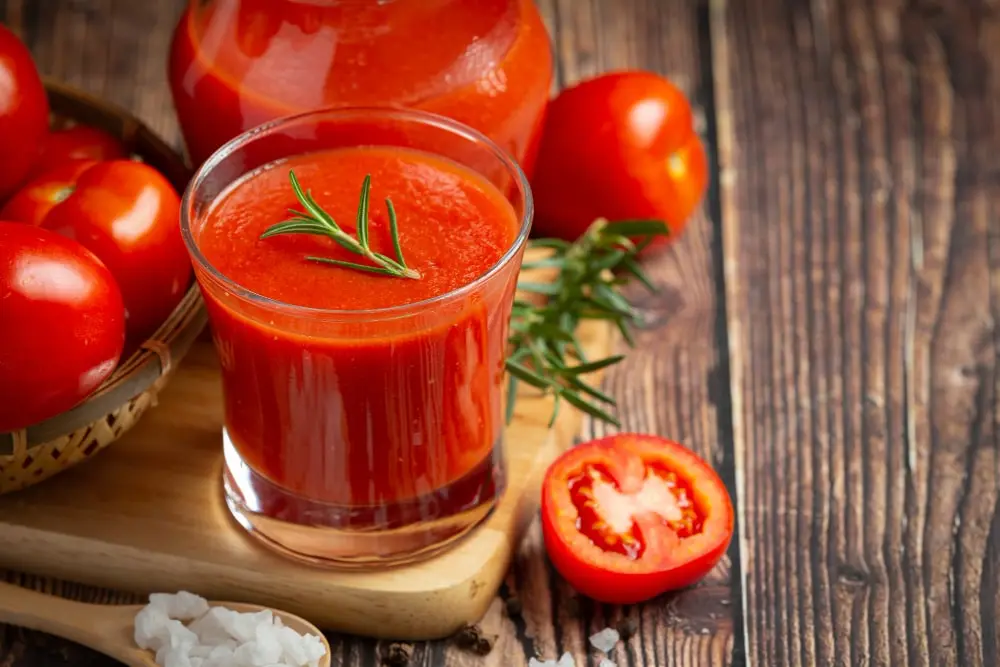Does Tomato Juice Go Bad?

Tomato juice packs a punch of health benefits. It contains antioxidants like lycopene, which fights off diseases and supports heart health by regulating blood pressure. The vitamins A and C in tomato juice are good for the eyes and skin, promoting vision and radiance.
It also helps keep bones strong with vitamin K and aids digestion with its fiber content. Being a low-calorie hydrator, it’s a smart choice for weight management. Plus, it has anti-inflammatory properties and is linked to a lower risk of certain cancers
If you are making tomato juice at home, ensure that you use fresh, ripe tomatoes and practice proper hygiene during the preparation process to minimize the risk of contamination.
How To Tell If Tomato Juice Go Bad?
Like other perishable food items, Tomato juice can go bad over time.
Here are some signs to determine if your tomato juice has gone bad:
1. Check the expiration date
Always start by checking the expiration date on the packaging. If the tomato juice has passed its expiration date then you need to discard it.
2. Inspect the appearance
Fresh tomato juice should be bright red. If it looks different or has turned brownish, it might be going bad.
3. Smell the juice
Spoiled tomato juice will emit an off-putting odor. If you detect any sour, rotten, or fermented smells, it indicates that the juice has spoiled.
4. Look for signs of mold
Mold growth is a clear indication that the tomato juice has spoiled. Check the surface of the juice for any visible mold growth or unusual spots.
5. Taste a small amount
If the appearance and smell seem okay, you can taste a small amount to check for any sour or unpleasant flavors. However, it is necessary to proceed with safety caution, as consuming spoiled tomato juice can lead to illness.
If you notice any of these signs, it’s best to err on the side of caution and discard the tomato juice to avoid any potential health risks.
Why Does Tomato Juice Go Bad?
Tomato juice, a popular and nutritious beverage, holds a coveted place in many households. Packed with essential vitamins, minerals, and antioxidants, it’s a refreshing and health-conscious choice.
However, despite its popularity, tomato juice is not immune to the inevitable process of deterioration. In this article, we delve into the various factors that contribute to the expiration and spoilage of tomato juice.
1. Microbial Growth
One of the primary reasons tomato juice succumbs to spoilage is the proliferation of microorganisms. Bacteria, molds, and yeast are omnipresent in our surroundings, and when tomato juice is exposed to these contaminants, they seize the opportunity to multiply.
Once these microorganisms take hold, they can induce changes in odor, taste, and texture, rendering the juice unsuitable for consumption.
2. Enzymatic Activity
Tomatoes contain enzymes that, when activated, can instigate chemical reactions within the juice. These reactions may result in alterations in flavor, color, and texture. Enzymatic activity is more pronounced if the tomatoes are not adequately processed or if the juice is exposed to conditions that encourage enzymatic reactions.
3. Oxidation
Exposure to air is a critical factor contributing to the spoilage of tomato juice. Oxidation, a natural process, occurs when the juice interacts with oxygen, leading to changes in taste and nutritional content. This breakdown of vitamins and other compounds can significantly impact the quality of the juice.
4. Light and Heat Sensitivity
Tomatoes are sensitive to light and heat. Excessive exposure to sunlight or elevated temperatures can accelerate the degradation of pigments, flavors, and nutrients in tomato juice.
Proper storage away from direct light and heat sources is crucial to mitigate these effects.
5. Packaging Issues
The packaging of tomato juice plays a pivotal role in determining its shelf life. If the container is improperly sealed or allows light penetration, the risk of spoilage increases.
Quality packaging helps protect the juice from external factors that can compromise its integrity.
6. Storage Conditions
Where and how you store tomato juice significantly influences its longevity. Storing it inappropriately, such as at room temperature or in fluctuating conditions, can hasten spoilage.
Refrigeration, on the other hand, slows down microbial growth and enzymatic reactions, preserving the quality of the juice.
7. Time
As with many perishable items, time is a formidable adversary to the shelf life of tomato juice. Even under optimal storage conditions, the quality of the juice may gradually decline over an extended period.
Frequently Asked Question
Is it safe to consume slightly discolored tomato juice?
Any significant deviation from the normal red color may indicate spoilage. It’s advisable to discard tomato juice with unusual discoloration as it may signify changes in taste, texture, or nutritional content.
How can I tell if tomato juice has gone bad?
Signs of spoiled tomato juice include an off odor, unusual color or texture, an off taste, mold growth, or packaging issues such as bulging or damage.
Conclusion
Understanding the factors contributing to the expiration of tomato juice is crucial for maintaining its freshness and safety. Whether through proper packaging, vigilant storage, or timely consumption, consumers can take proactive steps to extend the shelf life of tomato juice.
By being cognizant of these elements, one can savor the delightful and nutritious qualities of tomato juice while minimizing the risk of consuming a product that has gone bad.